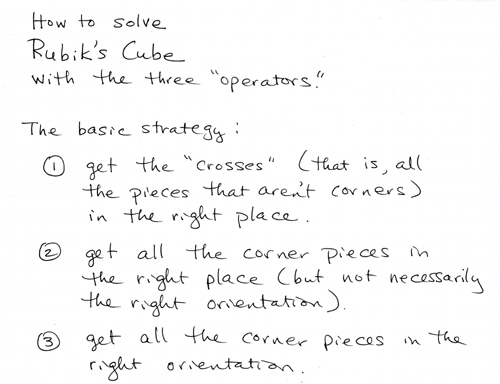You’ve probably already heard the news last week that a study published in Science indicates that the gender gap between girls and boys in mathematical performance may be melting faster than the polar ice caps. The study, “Gender Similarities Characterize Math Performance” by Janet S. Hyde et al., appears in the July 25, 2008 issue of Science (behind a paywall). [1]
Category Archives: Mathematics
Fear and loathing in the academy.
Today Chad has an interesting post about attitudes among academics toward math and science versus the humanities and arts. The general attitude Chad sees on display in his academic milieu is that a gappy knowledge of art history or music or literature is something to be embarrassed about, but when it comes to innumeracy or scientific ignorance, intellectuals have no shame.
Chad writes:
Arcane nerd knowledge revealed: a nice way to solve Rubik’s Cube.
Yesterday, one of the elder Free-Ride offspring’s teammates brought a Rubik’s Cube to soccer practice. While this youngster fiddled with the cube during a water break, I mentioned that I knew how to solve it. I was asked to transmit this knowledge, and I promised to write it up and send it to the player at this morning’s soccer match.
And I thought, “You know, there are probably others who might like this information.” So I made a quick detour to the scanner, and am sharing the very same information with you all.
I’m pretty sure that revealing this knowledge won’t get me drummed out of the Nerds’ Alliance, but I guess we’ll see.

Brief remarks on ‘physics first’ and high school science.
Chad and Rob have already noted this piece of news about soon-to-be-published research indicating that the order in which high school students are taught physics, chemistry, and biology makes very little difference to their performance in science classes at the college level, while a rigorous math curriculum in high school gives their college science performance a significant boost.
I have a few things to say about this.
Strategy is different when playing with a five-year-old.
The elder Free-Ride offspring has lately gotten into playing “poison”, a nim-type game for two players. You start with a pile of twelve items that are the same and one item that is different (the poison). Each turn, players can remove either one or two items from the pile. The object of the game is to leave your opponent with no option but to take the poison.
In theory, it is possible to win the game every single time if your turn is second. (Thanks to MarkP for straightening me out on this one.) What the elder Free-Ride offspring has discovered in playing with the younger Free-Ride offspring, however, is that there are circumstances in which a five-year-old will find it psychologically impossible to exercise a winning strategy even when given the second turn.
Two NYT stories worth a look.
Some readers have called to my attention a pair of recent stories from the New York Times that you may find interesting.
First, Audrey noted another dispatch on the eternal struggle over how math ought to be taught:
Why didn’t I see that before? (World Cup edition)
I’ve always liked soccer balls — and not just because you can play soccer with them. The arrangement of pentagons and hexagons to form a surfaces that’s reasonable spherical always seemed outstandingly clever. Who was the genius who first realized you could do that?
Well, my world has been rocked. I still think the soccer ball is clever, but in and entirely different kind of way. Tonight I was flipping through the copy of American Scientist that arrived with today’s mail, looking at the pictures*, and I came across this article on the topology (and combinatorics) of soccer balls. (The full article online requires a subscription.) Figure 8 revealed that a soccer ball is nothing but an icosohedron (that is, a Platonic solid with 20 faces, each of which is an equilateral triangle), each of whose 12 vertices is truncated. Chopping off each vertex leave a pentagonal face (so chopping off 12 vertices yields 12 pentagonal faces). And, each of these truncations chops off the corners of the faces that met to make the vertices you chopped off — turning the 20 equilateral triangles into 20 regular hexagons.
Whoa!
